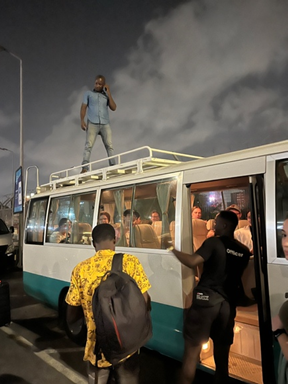Day 4: Cuckoo for Cocoa (Puffs)!
I will put some of the Twi we have learned to use by saying Maakye, Maaha or Maadwo
(Good morning, afternoon or evening)! I am Sophie, a junior from Edina, MN majoring in Finance with a double
minor in Business Analytics and French.
Bright and early, we hopped on
the tro tro (our bus) to venture east of Accra and immerse ourselves in the beautiful nature Ghana has to
offer.
As we drove up the steep and
windy hills away from Accra proper, there was an immediate shift in socioeconomic
status. The disparity was evident by the number of mansions that sat
atop the hills overlooking the crowded city. We joked that Chance the Rapper
likely owned a home up in that area somewhere near the Presidential Suite.
Despite the large homes, one of the most prominent features of Ghana – the small family
shops alongside the road – remained relatively unchanged.
From here, we headed to
Aburi Botanical Gardens. The garden sits on 160 acres of land where diversity in horticulture is apparent with the
ultimate purpose of maintaining natural reserves. In summary of our
visit, I will say it was a tour around the world in 60 minutes. The garden
consists of trees and plants from America all the way to Asia.
Throughout our visit, our wonderful guide, Maxwell, showed us the beauty,
danger, and application of nature. For example, leaves from the teakwood tree can be rubbed together producing a red pigment and used as a
lipstick for women. Likewise, trees such as the African Konite tree can be used
medicinally as an anti-malaria treatment or a treatment for COVID-19 by boiling the leaves and drinking the water.
The cida tree was one of the
most fascinating. Over time, it becomes engulfed in soka vines, as shown above. The tree eventually dies and the vines remain, forming a hallowed structure
with holes that allow beams of light to pass through.
We concluded our tour with a stroll through what I would call an "au natural" Bath & Body Works. We smelled various tree leaves including cinnamon, allspice and bay leaves. It was amazing to visualize where these common household ingredients come from. I surely had no idea cinnamon sticks came from the bark of a tree. Yet the fun’s not over!








Comments
Post a Comment